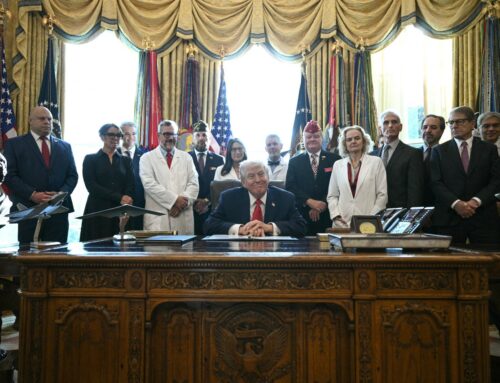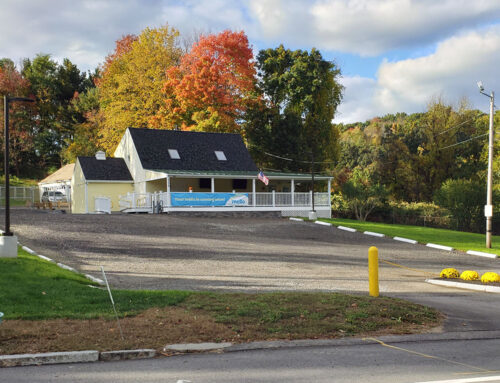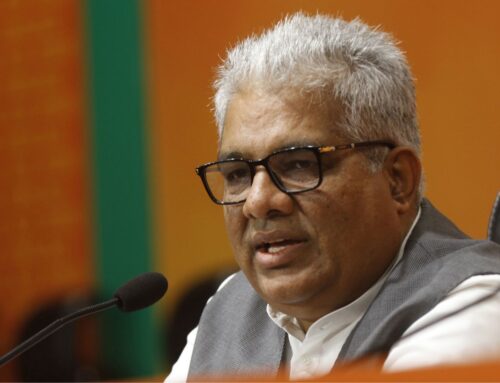As Trump Targets Biden’s Environmental Justice Initiatives, Activists Gear Up for Legal Fights
January 26, 2025
Activists across the United States say they’re preparing to take the federal government to court after President Donald Trump unveiled a series of executive orders Monday that seek to undo much of his predecessor’s climate and environmental justice legacy.
The executive orders, which Trump signed just hours after his second term began, target some of President Joe Biden’s key accomplishments, including the Justice40 Initiative. That program, which many advocates hailed as a major breakthrough for the environmental justice movement, directed federal agencies to deliver at least 40 percent of the “overall benefits” of their environmental and energy spending to “disadvantaged communities that have been historically marginalized and overburdened by pollution and underinvestment.”
Many government websites put up during Biden’s term, including the official Justice40 page and the White House environmental justice page, have been removed since Trump took office.
Other Biden initiatives that the Trump administration moved to reverse include:
- Two executive orders that directed federal agencies to explicitly take environmental justice into account when spending funds from the Bipartisan Infrastructure Law or the Inflation Reduction Act;
- One executive order that set a national goal to dramatically increase the sales of electric vehicles in the U.S. by 2030
- And one executive order that established the White House Environmental Justice Advisory Council, as well as offered federal assistance to struggling coal communities as the country transitions to cleaner energy sources.
Nearly 80 executive orders signed by Biden were revoked as of Tuesday, leading some advocates to speculate that Trump officials are attempting to overwhelm community organizers with the sheer number of actions being set in motion.
“They’re just going at everything, and there’s thousands of little programs,” said Maria Lopez-Nuñez, a New Jersey-based environmental justice organizer who sat on the now-disbanded White House Environmental Justice Advisory Council.
In a letter circulated Tuesday, House Democrats criticized the Trump administration, saying it was attempting “to dismantle the federal response to climate change, gut our bedrock pollution regulations, and run roughshod over landmark environmental protections.”
The Trump administration maintains the policy changes underway will improve protections. “President Trump advanced conservation and environmental stewardship while promoting economic growth for families across the country in his first term and will continue to do so this term,” a spokesperson for the Trump Environmental Protection Agency wrote in email comments.
Nevertheless, several advocates told Inside Climate News that they’re now gearing up for legal fights as they begin to comb through the slog of Trump orders.
“The lawyers are ready,” said Robert Bullard, founding director of the Bullard Center for Environmental and Climate Justice and distinguished professor of urban planning and environmental policy at Texas Southern University. “We’ve got to fight to make sure we don’t roll over and let things happen to us, but be ready and prepared to fight back.”
Activists Warn About Health Dangers
For decades, researchers and activists within the environmental justice movement have demonstrated how the most vulnerable communities—largely neighborhoods with large portions of low-income households, immigrants and people of color—have borne the brunt of the nation’s industrial pollution, while benefiting least from its environmental regulations.
Studies have long shown that people of color and low-income residents tend to live closer to polluting industries and infrastructure, like major highways and power plants. Research has also found that people of color disproportionately live in counties with unhealthy levels of air pollution. That has led to many of those communities suffering higher rates of asthma, cardiovascular disease and other health conditions when compared to the national average.
Now some health advocates are warning that Trump’s initial actions could exacerbate pollution in already disadvantaged communities and hinder efforts to improve those conditions, including efforts to curb the buildout of polluting industries.
“President Trump’s actions are an attack on communities across the country that are on the frontlines of deadly pollution,” Abigail Dillen, president of the environmental law firm Earthjustice, said in a statement. “With these initiatives, he will allow more pollution in our communities. This means more cancer clusters, more asthma attacks, bigger hospital bills and ultimately, more deaths among Americans.”
Lopez-Nuñez said Trump’s attack on Biden’s efforts to electrify the nation’s vehicles, as well as his efforts to claw back funding dedicated to helping disadvantaged communities clean up toxic waste and reduce overall pollution could mean increased health risks for neighborhoods like hers.
“I don’t know of any parent who wants their child to breathe dirtier air.”
— Almeta Cooper, Moms Clean Air Force
Newark, New Jersey’s Ironbound neighborhood, where she lives, is surrounded by major highways, multiple fossil fuel power plants and sits adjacent to one of the nation’s largest transportation hubs. It also suffers some of the worst air pollution in the country, according to the Clean Air Task Force.
Health and environmental advocates, including Lopez-Nuñez, say electrifying more cars could help directly reduce pollution in their neighborhoods. But some are worried those efforts could run into funding trouble under the new administration.
Almeta Cooper, national manager of health justice at the advocacy group Moms Clean Air Force, has been involved in a federal program that’s using $5 billion from the infrastructure law to replace diesel-powered school buses with electric ones. But Cooper said she’s worried about that program’s future since Trump took office. Supporters of the program say it will help reduce children’s exposure to harmful pollutants that can contribute to asthma, harm cognitive development and increase risks of cancer.
“I don’t know of any parent who wants their child to breathe dirtier air,” she said.
Louisiana-based organizer Roishetta Ozane said she worries Trump’s actions could worsen pollution where she lives. For years, she and other activists in the Gulf South have fought to stop the development of new liquified natural gas export terminals, which could contribute to air pollution in the already industry-saturated area.
Ozane said that during the Biden administration, frontline advocates had achieved big wins, including stricter federal limits on particle pollution and the administration’s pause on LNG export projects. But Trump lifted the freeze on Tuesday, signaling that developments activists have been fighting against could move forward.
“President Trump’s decisions will set us back several years … but I don’t want people to lose hope,” Ozane said. “It’s like I tell my children, you can’t back down to a bully.”
Court Fights Loom
Activists say they’re anticipating plenty of legal challenges in the coming months and years, especially pertaining to actions that could affect funding tied to the Inflation Reduction Act.
“I think that frontline community members will be in court a lot, trying to prove our rights are being violated,” Ozane said. “We feel like that is what’s gonna be our hope. We’re gearing up to go to court as much as we need to.”
Trump’s “Unleashing American Energy” executive order included a provision that directed federal agencies to “immediately pause disbursement” of any funds appropriated under the Inflation Reduction Act or the Bipartisan Infrastructure Act. According to a report the EPA issued last week on the IRA and infrastructure investments, about $2 billion has been obligated to community groups by the Biden administration. Recipients of some of the larger grants may not have all of the money in hand, but typically would draw it down from a government account as the work under the grant is completed. It is not clear whether the Trump administration intends to take the highly unusual step of holding back money the government already is contractually obligated to pay.
When asked, Trump administration officials did not directly address that question, but characterized the steps it is taking as in line with those taken during previous changes in leadership in Washington.
“Following common transition procedures, most major decisions have involved a pause, including a hold on new (not yet effective) and pending (not yet published) regulations, as well as funding disbursements,” an EPA spokesperson said in an email. “EPA is working diligently to implement President Trump’s executive orders. As part of standard transition procedures, most major decisions are undergoing a quick review process to ensure transparency and accountability to the American people.”
Even if the Trump administration disburses grants that are already obligated, about $1 billion, or one-third of the environmental justice community grant money that Congress appropriated in the IRA, has yet to be awarded.
“There’s going to be a big fight over the Inflation Reduction Act money,” said Michael Gerrard, an environmental law professor at Columbia University and director of the school’s Sabin Center for Climate Change Law. “The Biden administration tried to get as much of it out the door as possible. But the question was, how far out the door?”

Chandra Taylor-Sawyer, senior attorney and leader of Southern Environmental Law Center’s Environmental Justice Initiative, said she has doubts any of Trump’s executive orders aimed at the Inflation Reduction Act or the Bipartisan Infrastructure Law can withstand legal scrutiny.
The Impoundment Control Act of 1974 explicitly prohibits a president or other government officials from refusing to release congressionally appropriated funds and essentially substituting their own funding decisions for those of Congress.
“We’re a nation of laws that need to be complied with,” Taylor-Sawyer said. “A president cannot unilaterally make decisions to temporarily or permanently withhold funds that have been appropriated by a prior Congress.”
The Trump White House issued an additional guidance memorandum to agency leaders that was made public Wednesday, which said the pause applied only to termination of what Trump has been calling “the Green New Deal.” No section of the IRA or infrastructure act has that name, although it is likely a reference to their environmental and climate provisions.
“It was meant to clarify what programs were going to be affected, though it didn’t really clarify,” said Bobby Kogan, senior director of federal budget policy at the Center for American Progress, a Washington think tank. “I think we’ll know within the next couple days if folks start to miss their payments. I’m sure that they will flag stuff, and then they’ll sue the government, and they’ll win because they are legally owed that money.”
This story is funded by readers like you.
Our nonprofit newsroom provides award-winning climate coverage free of charge and advertising. We rely on donations from readers like you to keep going. Please donate now to support our work.
Gerrard said many of the executive orders Trump signed this week will face the public input process, which requires federal agencies to review public comments and make good-faith revisions to their proposed rules. Failing to respond to comments that provide relevant information, or inadequately explaining why a federal agency is disregarding such comments can result in court intervention, he added.
He pointed to a Supreme Court case decided last summer over a Clean Air Act rule. “The Supreme Court invalidated the rule because there was an adequate response to the comments,” he said.
Conflating “DEI” With Environmental Justice
Bullard’s foray into the issue of environmental justice began more than 40 years ago, before the movement even had a name.
In the late 1970s, Bullard helped his wife file a lawsuit to stop a company from building a landfill in a predominantly Black and middle-class neighborhood in Houston, arguing the company was discriminating against the Black community by selecting that location. Bullard lost the case, but his legal fight set a major precedent as the nation’s first lawsuit to challenge environmental discrimination using civil rights law.
The suit helped shape the environmental justice movement, which has largely dealt with addressing community issues such as reducing air pollution and protecting people from drinking water contamination—issues that have tended to crop up more frequently in low-income neighborhoods with large minority populations.

But Bullard said Trump and Republican allies are confusing the environmental justice movement with the effort to diversify schools and private businesses. That effort was once called affirmative action, but now more commonly goes by diversity, equity and inclusion, or DEI.
“It’s not the same,” Bullard said. “The right to breathe clean air, drink clean water and to have our food safe to eat and have our kids play on playgrounds that are not contaminated … that’s not DEI.”
On Tuesday night, Trump signed another executive order placing all federal employees working on DEI initiatives on immediate paid administrative leave.
“The previous administration has embedded deeply unpopular, inflationary, illegal, and radical practices within every agency and office of the Federal Government,” Trump wrote in the orders. “The injection of ‘diversity, equity, and inclusion’ (DEI) into our institutions has corrupted them by replacing hard work, merit, and equality with a divisive and dangerous preferential hierarchy.”
DEI in many ways has become a rallying cry for Republican lawmakers who have leaned into America’s culture wars. Trump made sure to mention DEI prominently in his Monday executive orders targeting environmental justice initiatives, using words like “corrupt,” “divisive” and “dangerous.”
The Justice40 Initiative in particular has drawn ire from conservatives, who argue that Democrats are using the program, and other climate initiatives, to award “taxpayer dollars to special interest groups committed to a radical energy agenda.”
“The right to breathe clean air, drink clean water and to have our food safe to eat and have our kids play on playgrounds that are not contaminated … that’s not DEI.”
— Robert Bullard, Bullard Center for Environmental and Climate Justice
But supporters of the program say Trump is hurting his own base by targeting Justice40 and IRA funding: Research has shown that the majority of IRA funding is also going to Republican-led states and GOP districts—many of them designated as “disadvantaged.”
“For too long, communities in Appalachia have struggled to access federal programs because small, often part-time municipal staff teams are not prepared to manage complex federal grant requirements,” Chelsea Barnes, the director of government affairs and strategy for Appalachian Voices, an environmental organization based out of North Carolina, Virginia and Tennessee, said in a statement. “The Justice40 initiative has helped to level the playing field for rural places.”
Lopez-Nuñez expressed a similar sentiment, saying: “Getting rid of Justice40 just hurts the average American, whether they can see it or not.”
As for Bullard, he remains hopefully optimistic.
“We have to think of the long view and think beyond four years,” he said. “If you think that somehow you can’t last four years, I’m giving you 45 years of experience. And some of us who’ve been working for four-plus decades, we’re still standing. We’re still saying, ‘Don’t give up.’”
About This Story
Perhaps you noticed: This story, like all the news we publish, is free to read. That’s because Inside Climate News is a 501c3 nonprofit organization. We do not charge a subscription fee, lock our news behind a paywall, or clutter our website with ads. We make our news on climate and the environment freely available to you and anyone who wants it.
That’s not all. We also share our news for free with scores of other media organizations around the country. Many of them can’t afford to do environmental journalism of their own. We’ve built bureaus from coast to coast to report local stories, collaborate with local newsrooms and co-publish articles so that this vital work is shared as widely as possible.
Two of us launched ICN in 2007. Six years later we earned a Pulitzer Prize for National Reporting, and now we run the oldest and largest dedicated climate newsroom in the nation. We tell the story in all its complexity. We hold polluters accountable. We expose environmental injustice. We debunk misinformation. We scrutinize solutions and inspire action.
Donations from readers like you fund every aspect of what we do. If you don’t already, will you support our ongoing work, our reporting on the biggest crisis facing our planet, and help us reach even more readers in more places?
Please take a moment to make a tax-deductible donation. Every one of them makes a difference.
Thank you,
Search
RECENT PRESS RELEASES
Related Post



